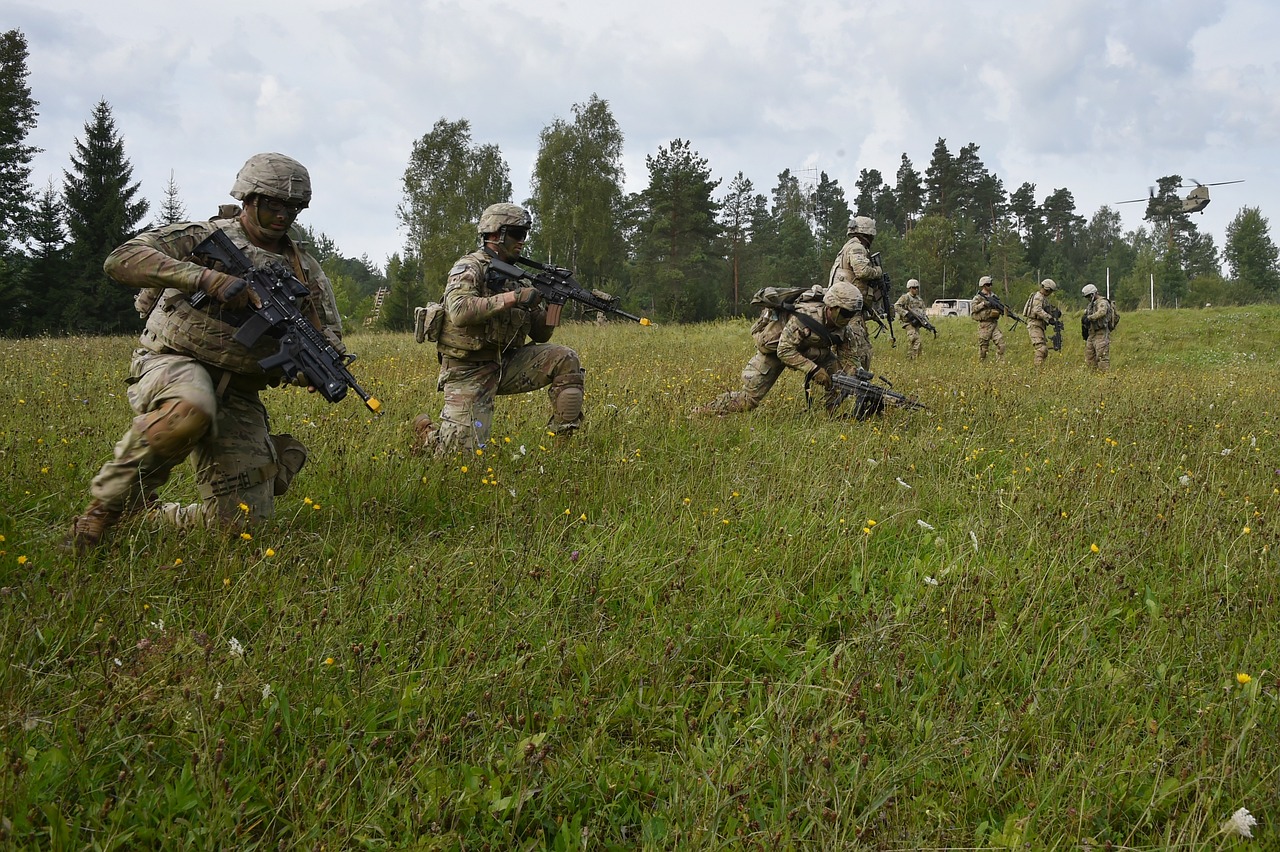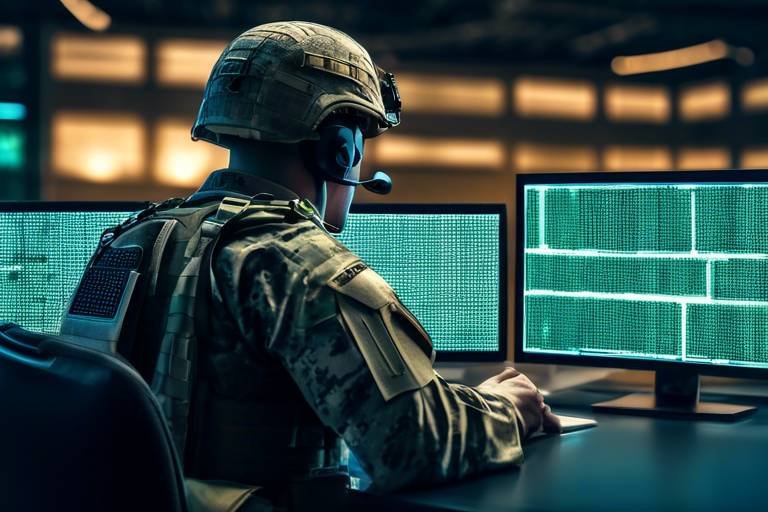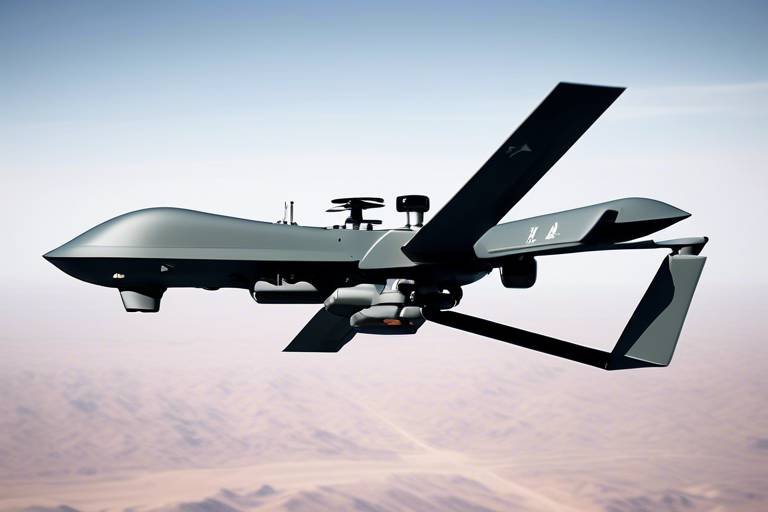How AI is Enhancing Military Personnel Training
In today's rapidly evolving battlefield, the need for highly skilled military personnel is more critical than ever. As warfare becomes increasingly complex, traditional training methods are being supplemented—and in some cases, replaced—by cutting-edge technologies. Enter artificial intelligence (AI), a game-changer in military training that is not just about robots and algorithms but about creating smarter, more adaptable soldiers. Imagine a world where soldiers can train in hyper-realistic environments, receive instant feedback on their performance, and learn at their own pace. This is not science fiction; it's happening right now, and the implications are profound.
AI is transforming military training by providing tailored learning experiences that cater to individual needs. No two soldiers are alike, and their training shouldn't be either. With AI, training programs can adapt in real-time based on a soldier's performance, ensuring that every individual gets the support they need to excel. This personalized approach is akin to having a personal coach who understands your strengths and weaknesses and adjusts the training regimen accordingly.
Moreover, the integration of AI into training allows for the creation of advanced simulations that mimic real-world combat scenarios. Picture this: a soldier in a virtual environment that replicates the chaos and unpredictability of an actual battlefield, complete with AI-driven opponents that respond intelligently to their actions. This not only enhances tactical skills but also prepares soldiers to make quick, informed decisions under pressure. It’s like playing a video game, but with life-and-death stakes.
As we delve deeper into the benefits of AI in military training, we uncover a landscape filled with opportunities and challenges. While the advantages are clear, the journey to fully integrate AI into military training is fraught with hurdles, from data security concerns to the need for substantial investment. Yet, the potential rewards far outweigh the risks, making AI an indispensable ally in the quest to prepare soldiers for the challenges of modern warfare.
AI technologies are revolutionizing military training by providing personalized learning experiences, real-time feedback, and advanced simulations that enhance skill acquisition and decision-making capabilities. These innovations are not only making training more efficient but also more engaging for the soldiers involved. With AI, training becomes less of a chore and more of an immersive experience, allowing personnel to focus on developing their skills in a supportive environment.
AI-driven training programs offer numerous advantages, including increased efficiency, cost-effectiveness, and the ability to adapt to individual learning styles. By leveraging data analytics, military trainers can identify areas where soldiers struggle and adjust the training content accordingly. This leads to better-prepared military personnel who can respond effectively to the demands of their roles.
AI systems can tailor training modules to the unique strengths and weaknesses of each soldier, ensuring that all personnel receive the most effective training suited to their needs. This personalization not only boosts confidence but also enhances retention of critical skills. Imagine a soldier who has always struggled with marksmanship; AI can identify this weakness and provide targeted exercises to improve their accuracy.
Adaptive learning algorithms analyze performance data to adjust training content dynamically, allowing for a more responsive and engaging training experience that maximizes skill development. This means that if a soldier excels in one area, the AI can shift focus to another, ensuring a well-rounded skill set.
Real-time analytics provide immediate feedback to trainees, enabling them to correct mistakes and improve their techniques during training exercises, fostering a culture of continuous improvement. This instant feedback loop is crucial—just like in sports, where athletes need to know what they're doing right or wrong in real-time to adjust their strategies.
AI-powered simulations create realistic training environments that mimic real-world scenarios, enhancing soldiers' decision-making and tactical skills under pressure. These simulations can be designed to replicate various terrains, weather conditions, and even enemy tactics, providing a comprehensive training experience that is as close to reality as possible.
Despite its benefits, integrating AI into military training presents challenges, including data security concerns, the need for significant investment, and potential resistance to technological change among personnel. Addressing these challenges is crucial for the successful adoption of AI technologies in military settings.
The use of AI in military training raises concerns about data security and privacy, necessitating robust measures to protect sensitive information from unauthorized access and cyber threats. As military training increasingly relies on data, ensuring the integrity and confidentiality of this information is paramount.
Implementing AI-driven training systems requires substantial investment and careful resource allocation, which can pose challenges for military budgets and planning processes. However, the long-term benefits of having a highly skilled and adaptable military force justify the initial costs.
The future of AI in military training is promising, with advancements in machine learning, virtual reality, and augmented reality set to further enhance training effectiveness and soldier readiness. As technology continues to evolve, so too will the methods used to prepare our military personnel for the challenges ahead.
The combination of AI with virtual and augmented reality technologies will create immersive training experiences that prepare soldiers for complex operational environments. These technologies can simulate everything from urban warfare scenarios to natural disasters, ensuring that soldiers are ready for any situation they may encounter.
The future of military training will emphasize continuous learning, utilizing AI to provide ongoing education and skill refinement throughout a soldier's career, ensuring they remain adaptable and proficient. This approach not only enhances individual performance but also strengthens the overall effectiveness of the military as a whole.
- What are the main benefits of using AI in military training?
AI enhances training efficiency, personalizes learning experiences, and provides real-time feedback, leading to better-prepared soldiers. - How does AI personalize training for military personnel?
AI analyzes individual performance data to tailor training modules that address each soldier's unique strengths and weaknesses. - What challenges does the military face in implementing AI?
Challenges include data security concerns, significant investment requirements, and potential resistance to change among personnel. - What is the future of AI in military training?
The future includes advancements in virtual and augmented reality, leading to more immersive training experiences and a focus on continuous learning.

The Role of AI in Military Training
Artificial Intelligence (AI) is not just a buzzword; it’s a game changer in the realm of military training. Imagine a training environment where each soldier receives instruction tailored specifically to their individual strengths and weaknesses. This is precisely what AI brings to the table. By leveraging advanced algorithms and data analytics, military training programs can now provide personalized learning experiences that were previously unimaginable. This means that instead of a one-size-fits-all approach, each soldier can engage with training modules that resonate with their unique learning style.
Moreover, AI systems can analyze vast amounts of data in real-time, offering immediate feedback that helps trainees correct mistakes on the fly. This instantaneous response is crucial in a military setting, where split-second decisions can mean the difference between success and failure. The ability to receive real-time performance analytics fosters a culture of continuous improvement, pushing soldiers to refine their skills and enhance their decision-making capabilities.
One of the most exciting aspects of AI in military training is the use of advanced simulation technologies. These simulations create highly realistic training environments that replicate the complexities of modern warfare. Soldiers can practice their tactical skills in scenarios that mimic real-world situations, allowing them to hone their abilities under pressure. This immersive experience not only prepares them for the battlefield but also boosts their confidence by providing a safe space to make mistakes and learn.
To illustrate the impact of AI in military training, consider the following table that highlights key benefits:
| Benefit | Description |
|---|---|
| Personalization | Training tailored to individual needs and learning styles. |
| Real-Time Feedback | Immediate performance analytics to enhance skill development. |
| Advanced Simulations | Realistic training environments that prepare soldiers for real-life scenarios. |
| Continuous Improvement | A culture that encourages ongoing learning and adaptation. |
In summary, the role of AI in military training is multifaceted and transformative. It not only enhances the learning experience but also equips soldiers with the skills necessary to thrive in the unpredictable landscapes of modern warfare. As we look to the future, it’s clear that AI will continue to play a pivotal role in developing highly skilled military personnel, ensuring they are always ready for the challenges ahead.
- How does AI personalize military training? AI analyzes individual performance data to create customized training modules that cater to each soldier's unique strengths and weaknesses.
- What are the benefits of real-time feedback in training? Real-time feedback allows soldiers to correct mistakes instantly, fostering a culture of continuous improvement and enhancing skill acquisition.
- Can AI simulations replicate real-world scenarios? Yes, AI-powered simulations are designed to create realistic environments that closely mimic actual combat situations, improving tactical decision-making skills.
- What challenges does AI face in military training? Key challenges include data security concerns, the need for substantial investment, and potential resistance to change from personnel.

Benefits of AI-Driven Training Programs
AI-driven training programs are transforming the way military personnel are prepared for the complexities of modern warfare. The integration of artificial intelligence into training methodologies not only enhances the learning experience but also ensures that the training is tailored to meet the specific needs of each soldier. One of the most significant advantages of AI in military training is its ability to provide increased efficiency. Traditional training methods can often be time-consuming and may not address the unique learning pace of every individual. With AI, training modules can be adjusted in real-time, allowing soldiers to progress at their own speed, which leads to a more effective learning environment.
Moreover, AI-driven programs are cost-effective. While the initial investment in technology may seem substantial, the long-term savings are undeniable. By streamlining training processes and reducing the time required for each soldier to become proficient, militaries can allocate their resources more effectively. This not only cuts down on overall training costs but also minimizes the need for extensive physical training facilities, which can be expensive to maintain.
Another remarkable benefit is the ability to adapt training to individual learning styles. Every soldier has a different way of processing information and acquiring skills. AI systems can analyze a trainee's performance and adjust the training content accordingly. For instance, if a soldier struggles with tactical decision-making, the AI can provide more focused scenarios that address this weakness. This personalized learning experience ensures that each soldier is equipped with the skills they need to excel in their specific roles.
Furthermore, the implementation of real-time performance analytics is a game-changer. Imagine being in the middle of a training exercise and receiving immediate feedback on your performance. This capability allows soldiers to identify and correct mistakes on the spot, fostering a culture of continuous improvement. Instead of waiting for post-exercise evaluations, trainees can adjust their techniques and strategies in real-time, which significantly enhances their learning curve.
In terms of training effectiveness, AI-driven programs also facilitate the use of advanced simulation technologies. These simulations create highly realistic training scenarios that mimic real-world situations. Soldiers can practice their decision-making and tactical skills under pressure, preparing them for the unpredictability of actual combat situations. The immersive nature of these simulations ensures that trainees are not only learning but are also experiencing the psychological and emotional aspects of battlefield conditions.
In conclusion, the benefits of AI-driven training programs in the military are profound and multifaceted. From increased efficiency and cost-effectiveness to personalized learning and advanced simulations, AI is setting a new standard for military training. As we look to the future, it’s clear that embracing these technologies will be crucial in developing skilled personnel who are ready to face the challenges of modern warfare.
- What are AI-driven training programs?
AI-driven training programs utilize artificial intelligence technologies to enhance the training experience for military personnel, providing personalized learning, real-time feedback, and advanced simulations. - How do AI systems adapt to individual learning styles?
AI systems analyze performance data to tailor training modules to the strengths and weaknesses of each soldier, ensuring a customized learning experience. - What role do simulations play in AI military training?
Simulations create realistic training environments that mimic actual combat scenarios, enabling soldiers to practice decision-making and tactical skills under pressure. - Are there any challenges in implementing AI in military training?
Yes, challenges include data security concerns, the need for significant investment, and potential resistance to technological change among personnel.

Personalized Learning Experiences
This article explores the transformative role of artificial intelligence in military training, focusing on its benefits, applications, and future potential in developing skilled personnel for modern warfare.
AI technologies are revolutionizing military training by providing personalized learning experiences, real-time feedback, and advanced simulations that enhance skill acquisition and decision-making capabilities.
AI-driven training programs offer numerous advantages, including increased efficiency, cost-effectiveness, and the ability to adapt to individual learning styles, ultimately leading to better-prepared military personnel.
Imagine stepping into a training program that feels like it was designed just for you. powered by AI are doing just that for military personnel. These systems are not just one-size-fits-all; they analyze each soldier's unique strengths and weaknesses, crafting a tailored training journey that maximizes effectiveness. This means that a soldier who excels in tactical maneuvers but struggles with communication can receive focused training on the latter, while another soldier might get advanced tactical simulations to sharpen their skills further.
At the heart of this personalization are adaptive learning algorithms. These algorithms continuously assess a trainee's performance, adjusting the training content dynamically. For instance, if a soldier is struggling with a specific simulation, the AI can modify the scenario to provide additional practice in that area. This responsive approach keeps soldiers engaged and ensures they are always challenged at the right level.
Furthermore, real-time performance analytics play a critical role in this personalized learning experience. Imagine being in a training exercise and receiving instant feedback on your performance. This immediate insight allows soldiers to correct mistakes on the spot, making learning an active process rather than a passive one. It's like having a personal coach by your side, guiding you through every step and helping you refine your techniques.
To illustrate the impact of personalized learning experiences, consider the following table that highlights key aspects:
| Aspect | Description | Benefit |
|---|---|---|
| Adaptive Learning | Customizes training based on individual performance data. | Maximizes skill development by targeting weaknesses. |
| Real-Time Feedback | Provides immediate performance analytics during training. | Encourages continuous improvement and quick corrections. |
| Engagement | Maintains trainee interest through tailored content. | Enhances motivation and retention of skills. |
In summary, in military training foster an environment where each soldier can thrive. By leveraging AI technologies, the military is not only enhancing skill acquisition but also building a more adaptable and proficient force ready to tackle the challenges of modern warfare.
Despite its benefits, integrating AI into military training presents challenges, including data security concerns, the need for significant investment, and potential resistance to technological change among personnel.
The use of AI in military training raises concerns about data security and privacy, necessitating robust measures to protect sensitive information from unauthorized access and cyber threats.
Implementing AI-driven training systems requires substantial investment and careful resource allocation, which can pose challenges for military budgets and planning processes.
The future of AI in military training is promising, with advancements in machine learning, virtual reality, and augmented reality set to further enhance training effectiveness and soldier readiness.
The combination of AI with virtual and augmented reality technologies will create immersive training experiences that prepare soldiers for complex operational environments.
The future of military training will emphasize continuous learning, utilizing AI to provide ongoing education and skill refinement throughout a soldier's career, ensuring they remain adaptable and proficient.
- How does AI improve military training? AI enhances military training by personalizing learning experiences, providing real-time feedback, and creating advanced simulations that reflect real-world scenarios.
- What are the main benefits of AI-driven training programs? The main benefits include increased efficiency, adaptability to individual learning styles, and improved preparedness of military personnel.
- What challenges does AI face in military training? Key challenges include data security concerns, the need for significant investment, and potential resistance to change from personnel.
- What does the future hold for AI in military training? The future will see greater integration of AI with virtual and augmented reality, leading to immersive training experiences and a focus on continuous learning.

Adaptive Learning Algorithms
Adaptive learning algorithms are at the forefront of revolutionizing military training programs. These sophisticated systems analyze a soldier's performance in real-time and adjust the training content accordingly. Imagine a coach who watches every move you make, providing instant feedback and tweaking your training regimen to suit your unique needs. This is precisely what adaptive learning algorithms do—they create a personalized training experience that caters to the strengths and weaknesses of each individual.
By leveraging data analytics, these algorithms can identify patterns in a soldier's performance, pinpointing areas that require improvement. For instance, if a soldier struggles with marksmanship, the system can increase the frequency of shooting drills while simultaneously offering tailored advice to enhance technique. This dynamic approach ensures that every soldier is not just going through the motions but is actively engaged in a learning process that fosters real growth.
Moreover, adaptive learning algorithms utilize a variety of metrics to measure progress. These can include:
- Completion rates of training modules
- Accuracy in simulations
- Response times in critical scenarios
By continuously monitoring these metrics, the algorithms can adjust the difficulty level of training exercises to ensure that they remain challenging yet achievable. This balance keeps soldiers motivated and prevents the stagnation that can occur in traditional training environments.
Additionally, the implementation of these algorithms can lead to significant time savings. Instead of spending hours on generic training modules, soldiers can focus on the areas that matter most to them. This efficiency not only enhances skill acquisition but also optimizes training resources, allowing military organizations to allocate time and funding more effectively.
In summary, adaptive learning algorithms are not just a technological advancement; they represent a fundamental shift in how military training is approached. By personalizing the training experience, these algorithms not only enhance individual performance but also contribute to the overall effectiveness of military units. The future of military training is indeed bright, with adaptive learning algorithms leading the charge toward more skilled and prepared personnel.
- What are adaptive learning algorithms?
Adaptive learning algorithms are systems that analyze performance data and adjust training content dynamically to provide personalized learning experiences. - How do these algorithms improve military training?
They enhance training by tailoring modules to each soldier's unique strengths and weaknesses, ensuring more effective skill development. - Can adaptive learning algorithms save time in training?
Yes, by focusing on specific areas that need improvement, soldiers can complete training more efficiently, saving both time and resources. - Are there any challenges in implementing these algorithms?
Challenges include the need for robust data security measures, significant investment, and potential resistance to change among personnel.

Real-Time Performance Analytics
This article explores the transformative role of artificial intelligence in military training, focusing on its benefits, applications, and future potential in developing skilled personnel for modern warfare.
AI technologies are revolutionizing military training by providing personalized learning experiences, real-time feedback, and advanced simulations that enhance skill acquisition and decision-making capabilities.
AI-driven training programs offer numerous advantages, including increased efficiency, cost-effectiveness, and the ability to adapt to individual learning styles, ultimately leading to better-prepared military personnel.
AI systems can tailor training modules to the unique strengths and weaknesses of each soldier, ensuring that all personnel receive the most effective training suited to their needs.
Adaptive learning algorithms analyze performance data to adjust training content dynamically, allowing for a more responsive and engaging training experience that maximizes skill development.
Imagine being in a high-stakes training exercise where every second counts. are like having a personal coach by your side, offering immediate insights that can make the difference between success and failure. These systems continuously monitor a soldier's actions, providing instant feedback that helps trainees identify mistakes as they occur. This immediate correction is crucial because it fosters a culture of continuous improvement, where soldiers can refine their techniques on the fly.
For instance, during a simulated combat scenario, AI can track various performance metrics such as accuracy, reaction time, and decision-making speed. This data is then analyzed to generate real-time reports that highlight areas for improvement. The result? A more engaged and skilled soldier who is better prepared for real-world challenges. Below is a simplified example of how these analytics might be structured:
| Metric | Performance Score | Feedback |
|---|---|---|
| Accuracy | 85% | Increase focus on target acquisition |
| Reaction Time | 0.5 seconds | Excellent! Maintain this level |
| Decision-Making Speed | 3 seconds | Improve speed under pressure |
This kind of feedback loop is invaluable in military training. It allows soldiers to not only understand their current capabilities but also to see a clear path toward improvement. Furthermore, these analytics can be aggregated over time, enabling trainers to identify trends and make data-driven decisions about training programs. It’s like having a GPS for skill development, guiding soldiers through the complexities of modern warfare.
Despite its benefits, integrating AI into military training presents challenges, including data security concerns, the need for significant investment, and potential resistance to technological change among personnel.
The use of AI in military training raises concerns about data security and privacy, necessitating robust measures to protect sensitive information from unauthorized access and cyber threats.
Implementing AI-driven training systems requires substantial investment and careful resource allocation, which can pose challenges for military budgets and planning processes.
The future of AI in military training is promising, with advancements in machine learning, virtual reality, and augmented reality set to further enhance training effectiveness and soldier readiness.
The combination of AI with virtual and augmented reality technologies will create immersive training experiences that prepare soldiers for complex operational environments.
The future of military training will emphasize continuous learning, utilizing AI to provide ongoing education and skill refinement throughout a soldier's career, ensuring they remain adaptable and proficient.
- What is real-time performance analytics in military training?
Real-time performance analytics involve monitoring a soldier's actions during training and providing immediate feedback to enhance their skills. - How does AI personalize military training?
AI personalizes training by analyzing each soldier's strengths and weaknesses, tailoring programs to fit their individual needs. - What are the challenges of implementing AI in military training?
Challenges include data security concerns, the need for significant investment, and potential resistance from personnel. - What is the future of AI in military training?
The future includes advancements in machine learning, virtual reality, and continuous learning models to enhance training effectiveness.

Advanced Simulation Technologies
This article explores the transformative role of artificial intelligence in military training, focusing on its benefits, applications, and future potential in developing skilled personnel for modern warfare.
AI technologies are revolutionizing military training by providing personalized learning experiences, real-time feedback, and advanced simulations that enhance skill acquisition and decision-making capabilities.
AI-driven training programs offer numerous advantages, including increased efficiency, cost-effectiveness, and the ability to adapt to individual learning styles, ultimately leading to better-prepared military personnel.
AI systems can tailor training modules to the unique strengths and weaknesses of each soldier, ensuring that all personnel receive the most effective training suited to their needs.
Adaptive learning algorithms analyze performance data to adjust training content dynamically, allowing for a more responsive and engaging training experience that maximizes skill development.
Real-time analytics provide immediate feedback to trainees, enabling them to correct mistakes and improve their techniques during training exercises, fostering a culture of continuous improvement.
In the realm of military training, are a game changer. These AI-powered systems create immersive training environments that closely mimic real-world scenarios, allowing soldiers to practice and refine their skills under conditions that simulate the pressures of actual combat. Imagine stepping into a virtual battlefield where every sound, movement, and decision matters—this is the reality that AI simulations are creating.
These simulations are not just about realism; they also enhance decision-making skills and tactical proficiency. Soldiers can engage in scenarios that require quick thinking and strategic planning, all while receiving instant feedback on their performance. For example, during a simulated mission, AI can track a soldier's actions and choices, providing insights into what worked, what didn’t, and how to improve. This feedback loop is crucial for developing the adaptability and quick response times needed in modern warfare.
Moreover, the use of AI in simulations allows for a wide variety of training scenarios, from urban warfare to aerial combat. Here’s a quick breakdown of the types of scenarios soldiers might encounter:
- Urban Warfare: Simulating combat in city environments, focusing on close-quarters tactics.
- Counter-Terrorism Operations: Training for hostage rescue and neutralizing threats in civilian settings.
- Logistical Operations: Managing supply chains and resources during combat situations.
- Joint Operations: Coordinating with other branches of the military in complex missions.
As technology advances, the integration of virtual reality (VR) and augmented reality (AR) into these simulations is on the horizon, promising even more realistic and engaging training experiences. Soldiers could find themselves in a mixed-reality environment where they interact with both digital and physical elements, enhancing their situational awareness and readiness.
Despite its benefits, integrating AI into military training presents challenges, including data security concerns, the need for significant investment, and potential resistance to technological change among personnel.
The use of AI in military training raises concerns about data security and privacy, necessitating robust measures to protect sensitive information from unauthorized access and cyber threats.
Implementing AI-driven training systems requires substantial investment and careful resource allocation, which can pose challenges for military budgets and planning processes.
The future of AI in military training is promising, with advancements in machine learning, virtual reality, and augmented reality set to further enhance training effectiveness and soldier readiness.
The combination of AI with virtual and augmented reality technologies will create immersive training experiences that prepare soldiers for complex operational environments.
The future of military training will emphasize continuous learning, utilizing AI to provide ongoing education and skill refinement throughout a soldier's career, ensuring they remain adaptable and proficient.
- What are the main benefits of using AI in military training?
AI enhances training efficiency, provides personalized learning experiences, and allows for realistic simulations that improve decision-making skills. - How do advanced simulations work?
Advanced simulations use AI to create realistic training environments where soldiers can practice skills and receive real-time feedback on their performance. - What challenges do military organizations face when implementing AI?
Challenges include data security concerns, high costs, and potential resistance to new technologies among personnel. - What does the future hold for AI in military training?
The future includes greater integration of virtual and augmented reality, as well as a focus on continuous learning throughout a soldier's career.

Challenges in Implementing AI in Military Training
While the integration of artificial intelligence (AI) into military training offers remarkable benefits, it doesn't come without its fair share of challenges. One of the primary hurdles is data security and privacy issues. The military handles vast amounts of sensitive information, and incorporating AI systems raises concerns about protecting this data from unauthorized access and potential cyber threats. Ensuring that robust security measures are in place is not just a priority; it's a necessity. Imagine a scenario where a malicious entity gains access to training data that includes strategic insights or personnel information—this could lead to disastrous consequences.
Another significant challenge is the investment and resource allocation required to implement AI-driven training systems. Developing, maintaining, and upgrading these technologies demands substantial financial resources. Military budgets are often tight, and allocating funds for cutting-edge AI systems can be a contentious issue. Decision-makers must weigh the costs against the potential benefits, which can lead to delays in adopting these transformative technologies. The reality is that while AI can enhance training efficiency and effectiveness, the initial investment can be daunting.
Moreover, there exists a potential resistance to technological change among military personnel. Change can be intimidating, especially in environments where tradition and established practices have long been the norm. Some personnel may feel apprehensive about relying on AI for critical training processes, fearing that it could undermine their skills or judgment. To address this, it’s crucial to foster a culture of acceptance and understanding around AI technologies. Education and training on how to effectively utilize AI tools can help ease these concerns and encourage a more adaptable mindset within the ranks.
As we navigate these challenges, it's essential to acknowledge that the successful implementation of AI in military training will require a concerted effort across various levels of the military hierarchy. Collaboration between technology experts, military leaders, and training personnel is vital to ensure that AI systems are not only effective but also secure and widely accepted. With the right approach, the military can harness the full potential of AI, transforming how personnel are trained for the complexities of modern warfare.
- What are the main challenges of implementing AI in military training?
The main challenges include data security and privacy concerns, the need for significant investment, and potential resistance to technological change among personnel.
- How does AI improve military training?
AI enhances military training by providing personalized learning experiences, real-time feedback, and advanced simulations that improve skill acquisition and decision-making capabilities.
- What measures can be taken to address data security issues?
Robust cybersecurity protocols, regular audits, and comprehensive training on data protection can help safeguard sensitive information in AI systems.
- Why is investment a challenge for AI in military training?
Implementing AI systems requires substantial financial resources, which can be challenging to secure within tight military budgets.
- How can resistance to AI be mitigated among military personnel?
Education and training on AI technologies, along with fostering a culture of acceptance, can help mitigate resistance and encourage personnel to embrace technological advancements.

Data Security and Privacy Issues
This article explores the transformative role of artificial intelligence in military training, focusing on its benefits, applications, and future potential in developing skilled personnel for modern warfare.
AI technologies are revolutionizing military training by providing personalized learning experiences, real-time feedback, and advanced simulations that enhance skill acquisition and decision-making capabilities.
AI-driven training programs offer numerous advantages, including increased efficiency, cost-effectiveness, and the ability to adapt to individual learning styles, ultimately leading to better-prepared military personnel.
AI systems can tailor training modules to the unique strengths and weaknesses of each soldier, ensuring that all personnel receive the most effective training suited to their needs.
Adaptive learning algorithms analyze performance data to adjust training content dynamically, allowing for a more responsive and engaging training experience that maximizes skill development.
Real-time analytics provide immediate feedback to trainees, enabling them to correct mistakes and improve their techniques during training exercises, fostering a culture of continuous improvement.
AI-powered simulations create realistic training environments that mimic real-world scenarios, enhancing soldiers' decision-making and tactical skills under pressure.
Despite its benefits, integrating AI into military training presents challenges, including data security concerns, the need for significant investment, and potential resistance to technological change among personnel.
The use of AI in military training raises significant concerns regarding data security and privacy. As military organizations increasingly rely on AI systems to process sensitive information, the potential for unauthorized access and cyber threats becomes a pressing issue. This necessitates the implementation of robust security measures to protect classified data from breaches.
For instance, military databases containing training performance metrics, personal soldier information, and operational plans must be safeguarded against hacking attempts. Cybersecurity protocols, including encryption and multi-factor authentication, are essential in mitigating risks associated with data handling in AI systems.
Moreover, the collection of personal data for training purposes raises ethical questions about privacy. Soldiers may be uncomfortable with the extent of surveillance and data collection, fearing that their personal information could be misused or inadequately protected. Hence, military leaders must address these concerns by ensuring transparent data usage policies and secure data management practices.
To summarize, addressing data security and privacy issues is crucial for the successful implementation of AI in military training. The following measures can help alleviate concerns:
- Implementing strict access controls to limit who can view sensitive information.
- Regularly updating cybersecurity protocols to counter new threats.
- Conducting training on data privacy for all personnel involved in AI systems.
The future of AI in military training is promising, with advancements in machine learning, virtual reality, and augmented reality set to further enhance training effectiveness and soldier readiness.
The combination of AI with virtual and augmented reality technologies will create immersive training experiences that prepare soldiers for complex operational environments.
The future of military training will emphasize continuous learning, utilizing AI to provide ongoing education and skill refinement throughout a soldier's career, ensuring they remain adaptable and proficient.
Q1: How does AI personalize military training?
AI personalizes military training by analyzing individual performance data and tailoring training modules to meet the specific strengths and weaknesses of each soldier.
Q2: What are the main security concerns with AI in military training?
The main security concerns include unauthorized access to sensitive data, potential cyber threats, and the ethical implications of data privacy.
Q3: How can military organizations ensure data privacy?
Military organizations can ensure data privacy by implementing strict access controls, regularly updating cybersecurity measures, and providing training on data privacy for personnel.

Investment and Resource Allocation
This article explores the transformative role of artificial intelligence in military training, focusing on its benefits, applications, and future potential in developing skilled personnel for modern warfare.
AI technologies are revolutionizing military training by providing personalized learning experiences, real-time feedback, and advanced simulations that enhance skill acquisition and decision-making capabilities.
AI-driven training programs offer numerous advantages, including increased efficiency, cost-effectiveness, and the ability to adapt to individual learning styles, ultimately leading to better-prepared military personnel.
AI systems can tailor training modules to the unique strengths and weaknesses of each soldier, ensuring that all personnel receive the most effective training suited to their needs.
Adaptive learning algorithms analyze performance data to adjust training content dynamically, allowing for a more responsive and engaging training experience that maximizes skill development.
Real-time analytics provide immediate feedback to trainees, enabling them to correct mistakes and improve their techniques during training exercises, fostering a culture of continuous improvement.
AI-powered simulations create realistic training environments that mimic real-world scenarios, enhancing soldiers' decision-making and tactical skills under pressure.
Despite its benefits, integrating AI into military training presents challenges, including data security concerns, the need for significant investment, and potential resistance to technological change among personnel.
The use of AI in military training raises concerns about data security and privacy, necessitating robust measures to protect sensitive information from unauthorized access and cyber threats.
Implementing AI-driven training systems requires substantial investment and careful resource allocation. Military budgets are often stretched thin, making it crucial to prioritize funding for innovative technologies that can enhance training effectiveness. The initial costs of deploying AI can be daunting, but the long-term benefits, such as improved soldier readiness and reduced training time, can justify the expenditure.
Moreover, resource allocation extends beyond just financial investment. It involves a strategic approach to integrating AI within existing training frameworks. Military leaders must assess current capabilities and identify gaps that AI can fill. This may involve:
- Evaluating existing training programs for compatibility with AI technologies.
- Training personnel to effectively use AI systems, ensuring they are not only users but also advocates for the technology.
- Establishing partnerships with tech companies to leverage expertise in AI development and implementation.
Ultimately, successful investment in AI training systems hinges on a comprehensive strategy that aligns technological advancements with military objectives. This alignment ensures that resources are not just allocated, but are used efficiently to maximize training outcomes.
The future of AI in military training is promising, with advancements in machine learning, virtual reality, and augmented reality set to further enhance training effectiveness and soldier readiness.
The combination of AI with virtual and augmented reality technologies will create immersive training experiences that prepare soldiers for complex operational environments.
The future of military training will emphasize continuous learning, utilizing AI to provide ongoing education and skill refinement throughout a soldier's career, ensuring they remain adaptable and proficient.
AI enhances military training by providing personalized learning experiences, real-time feedback, and advanced simulations that improve decision-making skills and overall preparedness.
AI systems analyze individual performance data to tailor training modules that address each soldier's unique strengths and weaknesses, ensuring effective learning outcomes.
Challenges include data security concerns, significant investment requirements, and potential resistance from personnel accustomed to traditional training methods.

Future Trends in AI Military Training
The landscape of military training is on the brink of a revolution, driven by the relentless advancement of artificial intelligence (AI). As we look toward the future, it's clear that AI will play an increasingly pivotal role in shaping how our armed forces prepare for the challenges of modern warfare. Imagine a training environment where soldiers engage in immersive simulations that accurately reflect the complexities of real battlefields. This is not just a possibility; it is an impending reality.
One of the most exciting trends is the integration of virtual reality (VR) and augmented reality (AR) into military training programs. These technologies, when combined with AI, will create hyper-realistic training scenarios that allow soldiers to practice their skills in a safe yet challenging environment. For instance, a soldier might find themselves in a simulated urban combat zone, where AI algorithms adjust the difficulty based on their performance, ensuring that each training session is tailored to their evolving skills. This kind of adaptive training not only enhances engagement but also significantly boosts retention of critical skills.
Moreover, the future of military training will emphasize continuous learning and development. Soldiers will not just undergo training during basic training or specialized courses; instead, they will engage in ongoing education throughout their careers. With AI's ability to analyze performance data over time, military training programs can provide personalized feedback and recommend further training opportunities. This means that a soldier could receive targeted resources to improve specific skills based on their performance metrics, fostering a culture of lifelong learning within the military.
As we consider these advancements, it's essential to address how they will reshape the training landscape. For example, the use of AI in training could lead to a more data-driven approach where decisions are made based on analytics rather than intuition alone. This shift could enhance strategic planning and operational readiness. However, it will also require military personnel to adapt to new technologies and methodologies, which can be a significant cultural shift.
In summary, the future of AI in military training is not just about adopting new technologies; it's about fundamentally transforming how soldiers learn and prepare for their roles. The integration of AI with VR and AR, coupled with a focus on continuous development, promises to create a more skilled, adaptable, and ready military force. As we embrace these changes, the potential for enhanced operational effectiveness and soldier readiness is truly exciting.
- What is the role of AI in military training?
AI enhances military training by providing personalized learning experiences, real-time feedback, and advanced simulations that improve skill acquisition. - How does virtual reality improve military training?
Virtual reality creates realistic training environments that allow soldiers to practice their skills in a safe yet challenging setting. - Will AI replace traditional training methods?
No, AI will complement traditional training methods, making them more effective and tailored to individual needs. - What are the challenges of implementing AI in military training?
Challenges include data security concerns, the need for significant investment, and potential resistance to change among personnel.

Integration of Virtual and Augmented Reality
This article explores the transformative role of artificial intelligence in military training, focusing on its benefits, applications, and future potential in developing skilled personnel for modern warfare.
AI technologies are revolutionizing military training by providing personalized learning experiences, real-time feedback, and advanced simulations that enhance skill acquisition and decision-making capabilities.
AI-driven training programs offer numerous advantages, including increased efficiency, cost-effectiveness, and the ability to adapt to individual learning styles, ultimately leading to better-prepared military personnel.
AI systems can tailor training modules to the unique strengths and weaknesses of each soldier, ensuring that all personnel receive the most effective training suited to their needs.
Adaptive learning algorithms analyze performance data to adjust training content dynamically, allowing for a more responsive and engaging training experience that maximizes skill development.
Real-time analytics provide immediate feedback to trainees, enabling them to correct mistakes and improve their techniques during training exercises, fostering a culture of continuous improvement.
AI-powered simulations create realistic training environments that mimic real-world scenarios, enhancing soldiers' decision-making and tactical skills under pressure.
Despite its benefits, integrating AI into military training presents challenges, including data security concerns, the need for significant investment, and potential resistance to technological change among personnel.
The use of AI in military training raises concerns about data security and privacy, necessitating robust measures to protect sensitive information from unauthorized access and cyber threats.
Implementing AI-driven training systems requires substantial investment and careful resource allocation, which can pose challenges for military budgets and planning processes.
The future of AI in military training is promising, with advancements in machine learning, virtual reality, and augmented reality set to further enhance training effectiveness and soldier readiness.
The integration of Virtual Reality (VR) and Augmented Reality (AR) with AI technologies is paving the way for a revolutionary shift in military training. Imagine soldiers stepping into a lifelike battlefield simulation where they can practice tactics and strategies without the risks associated with real-life scenarios. This immersive experience not only enhances engagement but also allows for a deeper understanding of complex operational environments.
With VR, trainees can experience a 360-degree view of simulated combat situations. They can interact with virtual environments and make decisions in real-time, honing their skills in a controlled yet realistic setting. On the other hand, AR overlays digital information onto the real world, providing soldiers with critical data while they are in the field. This combination of technologies creates a training environment that is not only safe but also incredibly effective.
For instance, during a training exercise, soldiers equipped with AR goggles can receive live updates on enemy positions, weather changes, and tactical advice, all while navigating through a physical landscape. This real-time information can drastically improve their situational awareness and decision-making capabilities.
Moreover, the data collected during these training sessions can be analyzed by AI algorithms to further refine training programs. By understanding how soldiers react in various scenarios, military trainers can adjust the training content to better meet the needs of their personnel. In this way, the integration of VR and AR is not just about creating a more engaging training experience; it’s about enhancing overall readiness and adaptability in a rapidly changing battlefield.
- What is the role of AI in military training?
AI enhances military training by providing personalized learning experiences, real-time feedback, and advanced simulations that improve skill acquisition and decision-making.
- How does virtual reality improve military training?
Virtual reality creates immersive training environments that allow soldiers to practice tactics and strategies in realistic scenarios without the associated risks of real combat.
- What challenges does AI face in military training?
Challenges include data security concerns, significant investment requirements, and potential resistance to adopting new technologies among military personnel.
- What are the future trends in military training?
Future trends include advancements in machine learning, virtual reality, and augmented reality, which will further enhance training effectiveness and soldier readiness.

Continuous Learning and Development
This article explores the transformative role of artificial intelligence in military training, focusing on its benefits, applications, and future potential in developing skilled personnel for modern warfare.
AI technologies are revolutionizing military training by providing personalized learning experiences, real-time feedback, and advanced simulations that enhance skill acquisition and decision-making capabilities.
AI-driven training programs offer numerous advantages, including increased efficiency, cost-effectiveness, and the ability to adapt to individual learning styles, ultimately leading to better-prepared military personnel.
AI systems can tailor training modules to the unique strengths and weaknesses of each soldier, ensuring that all personnel receive the most effective training suited to their needs.
Adaptive learning algorithms analyze performance data to adjust training content dynamically, allowing for a more responsive and engaging training experience that maximizes skill development.
Real-time analytics provide immediate feedback to trainees, enabling them to correct mistakes and improve their techniques during training exercises, fostering a culture of continuous improvement.
AI-powered simulations create realistic training environments that mimic real-world scenarios, enhancing soldiers' decision-making and tactical skills under pressure.
Despite its benefits, integrating AI into military training presents challenges, including data security concerns, the need for significant investment, and potential resistance to technological change among personnel.
The use of AI in military training raises concerns about data security and privacy, necessitating robust measures to protect sensitive information from unauthorized access and cyber threats.
Implementing AI-driven training systems requires substantial investment and careful resource allocation, which can pose challenges for military budgets and planning processes.
The future of AI in military training is promising, with advancements in machine learning, virtual reality, and augmented reality set to further enhance training effectiveness and soldier readiness.
The combination of AI with virtual and augmented reality technologies will create immersive training experiences that prepare soldiers for complex operational environments.
In the ever-evolving landscape of military operations, are paramount. AI will play a crucial role in fostering a culture of lifelong learning among military personnel. Imagine a world where soldiers are not just trained for a mission but are equipped with the ability to learn and adapt continuously throughout their careers. This transformative approach will ensure that they are always prepared for the unexpected.
With AI-driven platforms, training can extend beyond traditional classroom settings. For instance, soldiers can engage in microlearning modules that are easily accessible via mobile devices. This means that during downtime, personnel can review critical skills or learn new tactics on the go. The flexibility of AI allows for training to be integrated into daily routines, making learning a seamless part of military life.
Moreover, AI can analyze individual performance over time, identifying areas where soldiers excel and where additional focus is needed. This data-driven approach enables tailored development plans, ensuring that every soldier receives the guidance they need to grow. Imagine a scenario where a soldier shows exceptional aptitude in leadership during simulations, while another may struggle with technical skills. AI can highlight these strengths and weaknesses, facilitating targeted training sessions that enhance overall unit effectiveness.
As we look to the future, the emphasis on continuous learning will likely lead to a shift in military culture. No longer will training be viewed as a one-time event; instead, it will evolve into an ongoing journey of skill refinement and professional development. This shift not only prepares soldiers for immediate challenges but also equips them with the tools necessary for future conflicts and operational demands.
- How does AI personalize military training? AI analyzes individual performance data and adjusts training modules to suit each soldier's unique strengths and weaknesses, ensuring effective learning experiences.
- What are the benefits of continuous learning in the military? Continuous learning fosters adaptability, enhances skill refinement, and keeps military personnel prepared for evolving challenges in warfare.
- Are there any challenges in implementing AI in military training? Yes, challenges include data security concerns, significant investment requirements, and potential resistance to technological change among personnel.
- How do AI simulations improve military training? AI simulations create realistic environments that mimic real-world scenarios, enhancing decision-making and tactical skills under pressure.
Frequently Asked Questions
- How is AI changing military training?
AI is revolutionizing military training by providing tailored learning experiences, real-time feedback, and sophisticated simulations that enhance soldiers' skills and decision-making capabilities. It allows for a more personalized approach, ensuring that each trainee can learn at their own pace and according to their unique needs.
- What are the benefits of AI-driven training programs?
AI-driven training programs offer several advantages, including increased efficiency, cost-effectiveness, and adaptability to individual learning styles. This leads to better-prepared military personnel who can respond effectively in diverse and challenging situations.
- What are personalized learning experiences in military training?
Personalized learning experiences refer to the customization of training modules based on each soldier's strengths and weaknesses. AI systems analyze performance data to create tailored training paths that maximize skill development and ensure that everyone receives the most effective training possible.
- How do adaptive learning algorithms work?
Adaptive learning algorithms work by analyzing a trainee's performance in real-time. They adjust the training content dynamically, providing a more engaging and responsive experience that helps trainees improve their skills more effectively. It’s like having a personal coach that knows exactly when to push you harder or ease off.
- What role do advanced simulations play in military training?
Advanced simulations create realistic training environments that mimic real-world scenarios. This helps soldiers enhance their decision-making and tactical skills under pressure, preparing them for the complexities of actual combat situations.
- What challenges does AI face in military training implementation?
Challenges include data security and privacy concerns, significant investment needs, and potential resistance to technological changes among personnel. Ensuring the protection of sensitive data while integrating new technologies is crucial for successful implementation.
- How can data security issues be addressed in AI military training?
Addressing data security issues involves implementing robust measures to protect sensitive information from unauthorized access and cyber threats. This includes encryption, secure data storage solutions, and regular audits to ensure compliance with security protocols.
- What does the future hold for AI in military training?
The future of AI in military training looks promising, with advancements in machine learning, virtual reality, and augmented reality poised to enhance training effectiveness. These technologies will create immersive experiences that better prepare soldiers for complex operational environments.
- How will continuous learning be integrated into military training?
Continuous learning will be emphasized through AI systems that provide ongoing education and skill refinement throughout a soldier's career. This ensures that personnel remain adaptable and proficient, ready to meet the evolving demands of modern warfare.



















